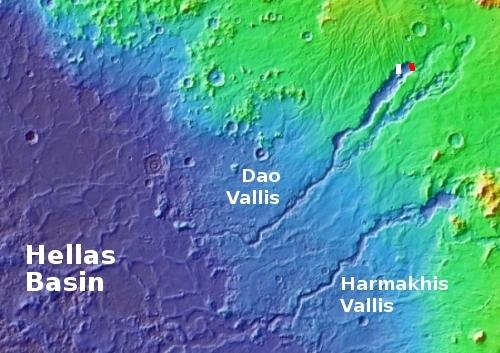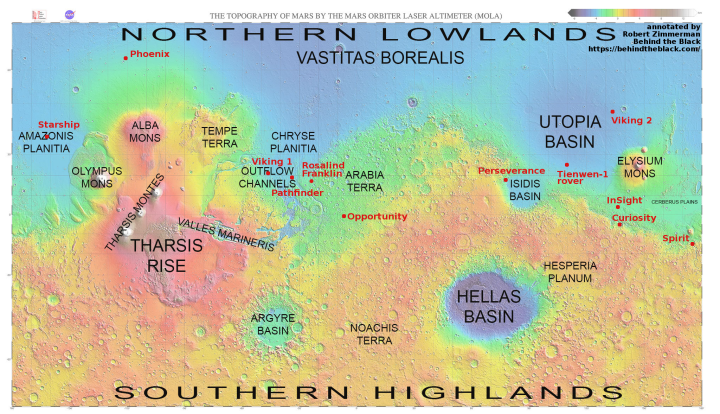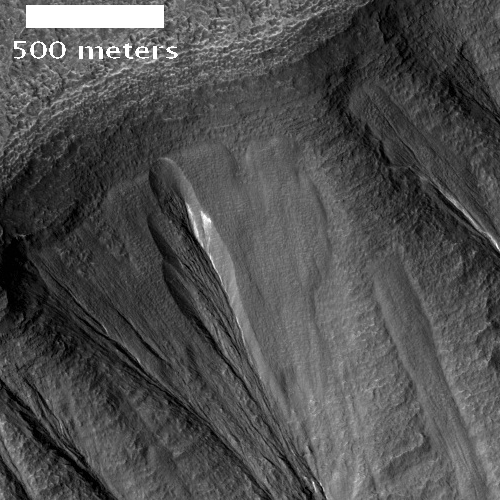New paper: Underlying ice layer seen in Martian gullies at LOW mid-latitudes
In a paper just published, scientists are proposing that bright areas seen in the low mid-latitude gullies on Mars are the underground ice table newly exposed as surface dust is removed.
This paper is a reiteration in more detail of a previous presentation [pdf] by these same scientists at the 2019 the 50th Lunar and Planetary Science Conference in Texas and reported here in March 2019.
The image to the right, from the paper, was taken by the high resolution camera of Mars Reconnaissance Orbiter (MRO) in 2009, and has been cropped to post here. The white streaks are what the scientists propose is that exposed underground ice table. At 32.9 south latitude, this particular gully would be the closest to the equator that such an ice layer has been identified. All the previous ice layer discoveries have been in the ice scarps found at latitudes above 50 degrees. As the paper’s lead author, Aditya Khuller at Arizona State University, explained in to me in an email, “We believe we are seeing exposures of dusty ice that likely originated as dusty snow.” From their paper:
We suggest … that the light-toned materials are exposed H2O ice. … [T]he appearance, and then subsequent disappearance of these light-toned materials, suggests that they are some form of volatile, such as dusty ice, rather than dust alone. … [The appearance] of these light-toned materials is similar to the >100m thick, light-toned ice deposits exposed on steep mid-latitude scarps, indicating that these materials are probably also ice, with some amount of dust on, and within the ice.
The layer would have likely been laid down as snow during a time period (a long time ago) when the rotational tilt of Mars, its obliquity, was much higher than today’s 25 degrees. At that time the mid-latitudes were colder than the poles, and water was sublimating from the polar ice caps to fall as snow in the mid-latitudes.
The overview map below reveals some additional intriguing possibilities.

The white rectangle indicates the location of this particular gully. It is only about 25 miles from the abrupt end of Dao Vallis, suggesting that the ice/water that once flowed through Dao and carved it might have come out of this very ice layer at the canyon’s head.
This December 7, 2018 photo by MRO’s high resolution camera takes a look at the head of this canyon and the gullies found on its slope (its location is indicated by the red rectangle on the overview map). While there is no obvious evidence of the same bright patches and thus an ice layer, the slope wall is filled with similar gullies, all presumably formed by the same process. As the ice layer was exposed in the summer, a bit was sublimated or melted away, causing the gully to form and for the cliff to retreat slightly.
Given enough time and that retreat could form the canyon.
At this time however this is merely a hypothesis. As Khuller explained,
I have personally not seen other exposed ice at the end of Dao, but Dao does have a similar mantling layer present on much of its pole-facing walls, which are also likely to contain similar dusty ice. We are in the process of documenting more such exposures within other mid-latitude gullies.
As I noted in my March 2019 post describing this research,
As always, I think like a colonist on Mars. These cliffs now appear to me as prime real estate, places to look for easily accessible water on Mars. That they are near Hellas Basin increases their value, as the low elevation of this basin means it will have a thicker atmosphere which will ease colonization. If we can find some caves in this region, we might then have all the ingredients for building that first Martian colony.
Ironically, no one has sent or is even planning to send a rover or lander to the southern hemisphere of Mars. All research has presently been confined to either the northern lowland plains, or to the transition zone between those lowlands and the southern cratered highlands, which generally sits in the northern hemisphere or near the equator, as shown by the global map of Mars below:

If I was thinking of exploring or colonizing Mars, however, the head of Dao canyon — on the northeastern border of Hellas Basin and at only about 30 degrees south latitude — appears to be prime real estate, and certainly deserves a closer look. Who wants to go?
On Christmas Eve 1968 three Americans became the first humans to visit another world. What they did to celebrate was unexpected and profound, and will be remembered throughout all human history. Genesis: the Story of Apollo 8, Robert Zimmerman's classic history of humanity's first journey to another world, tells that story, and it is now available as both an ebook and an audiobook, both with a foreword by Valerie Anders and a new introduction by Robert Zimmerman.
The print edition can be purchased at Amazon or from any other book seller. If you want an autographed copy the price is $60 for the hardback and $45 for the paperback, plus $8 shipping for each. Go here for purchasing details. The ebook is available everywhere for $5.99 (before discount) at amazon, or direct from my ebook publisher, ebookit. If you buy it from ebookit you don't support the big tech companies and the author gets a bigger cut much sooner.
The audiobook is also available at all these vendors, and is also free with a 30-day trial membership to Audible.
"Not simply about one mission, [Genesis] is also the history of America's quest for the moon... Zimmerman has done a masterful job of tying disparate events together into a solid account of one of America's greatest human triumphs."--San Antonio Express-News
In a paper just published, scientists are proposing that bright areas seen in the low mid-latitude gullies on Mars are the underground ice table newly exposed as surface dust is removed.
This paper is a reiteration in more detail of a previous presentation [pdf] by these same scientists at the 2019 the 50th Lunar and Planetary Science Conference in Texas and reported here in March 2019.
The image to the right, from the paper, was taken by the high resolution camera of Mars Reconnaissance Orbiter (MRO) in 2009, and has been cropped to post here. The white streaks are what the scientists propose is that exposed underground ice table. At 32.9 south latitude, this particular gully would be the closest to the equator that such an ice layer has been identified. All the previous ice layer discoveries have been in the ice scarps found at latitudes above 50 degrees. As the paper’s lead author, Aditya Khuller at Arizona State University, explained in to me in an email, “We believe we are seeing exposures of dusty ice that likely originated as dusty snow.” From their paper:
We suggest … that the light-toned materials are exposed H2O ice. … [T]he appearance, and then subsequent disappearance of these light-toned materials, suggests that they are some form of volatile, such as dusty ice, rather than dust alone. … [The appearance] of these light-toned materials is similar to the >100m thick, light-toned ice deposits exposed on steep mid-latitude scarps, indicating that these materials are probably also ice, with some amount of dust on, and within the ice.
The layer would have likely been laid down as snow during a time period (a long time ago) when the rotational tilt of Mars, its obliquity, was much higher than today’s 25 degrees. At that time the mid-latitudes were colder than the poles, and water was sublimating from the polar ice caps to fall as snow in the mid-latitudes.
The overview map below reveals some additional intriguing possibilities.

The white rectangle indicates the location of this particular gully. It is only about 25 miles from the abrupt end of Dao Vallis, suggesting that the ice/water that once flowed through Dao and carved it might have come out of this very ice layer at the canyon’s head.
This December 7, 2018 photo by MRO’s high resolution camera takes a look at the head of this canyon and the gullies found on its slope (its location is indicated by the red rectangle on the overview map). While there is no obvious evidence of the same bright patches and thus an ice layer, the slope wall is filled with similar gullies, all presumably formed by the same process. As the ice layer was exposed in the summer, a bit was sublimated or melted away, causing the gully to form and for the cliff to retreat slightly.
Given enough time and that retreat could form the canyon.
At this time however this is merely a hypothesis. As Khuller explained,
I have personally not seen other exposed ice at the end of Dao, but Dao does have a similar mantling layer present on much of its pole-facing walls, which are also likely to contain similar dusty ice. We are in the process of documenting more such exposures within other mid-latitude gullies.
As I noted in my March 2019 post describing this research,
As always, I think like a colonist on Mars. These cliffs now appear to me as prime real estate, places to look for easily accessible water on Mars. That they are near Hellas Basin increases their value, as the low elevation of this basin means it will have a thicker atmosphere which will ease colonization. If we can find some caves in this region, we might then have all the ingredients for building that first Martian colony.
Ironically, no one has sent or is even planning to send a rover or lander to the southern hemisphere of Mars. All research has presently been confined to either the northern lowland plains, or to the transition zone between those lowlands and the southern cratered highlands, which generally sits in the northern hemisphere or near the equator, as shown by the global map of Mars below:

If I was thinking of exploring or colonizing Mars, however, the head of Dao canyon — on the northeastern border of Hellas Basin and at only about 30 degrees south latitude — appears to be prime real estate, and certainly deserves a closer look. Who wants to go?
On Christmas Eve 1968 three Americans became the first humans to visit another world. What they did to celebrate was unexpected and profound, and will be remembered throughout all human history. Genesis: the Story of Apollo 8, Robert Zimmerman's classic history of humanity's first journey to another world, tells that story, and it is now available as both an ebook and an audiobook, both with a foreword by Valerie Anders and a new introduction by Robert Zimmerman.
The print edition can be purchased at Amazon or from any other book seller. If you want an autographed copy the price is $60 for the hardback and $45 for the paperback, plus $8 shipping for each. Go here for purchasing details. The ebook is available everywhere for $5.99 (before discount) at amazon, or direct from my ebook publisher, ebookit. If you buy it from ebookit you don't support the big tech companies and the author gets a bigger cut much sooner.
The audiobook is also available at all these vendors, and is also free with a 30-day trial membership to Audible.
"Not simply about one mission, [Genesis] is also the history of America's quest for the moon... Zimmerman has done a masterful job of tying disparate events together into a solid account of one of America's greatest human triumphs."--San Antonio Express-News


